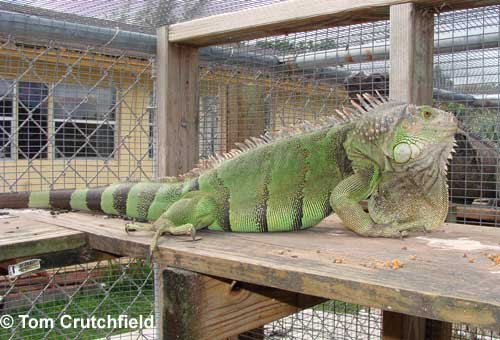
Understanding Green Iguana Size
When it comes to size, green iguanas are no joke. They can grow significantly during their lifespan, which can last 15 years or more with proper care. In fact, most of their growth happens during their first few years. Juvenile iguanas can start at about 12 inches long, but don’t let that small size fool you! Over the next few years, they can become quite the handful.
Adult iguanas typically reach lengths of 4 to 6 feet. This includes their long, slender tails, which actually make up about half of their total body length. For perspective, that’s longer than a standard guitar! If you’re dreaming of an iguana being a cute little companion, remember that they will grow up—fast.
Factors Influencing Size
Several factors can influence the size of a green iguana. Genetics plays a significant role; some iguanas are simply predisposed to be larger than others. Additionally, their diet and overall care can affect their growth. A balanced diet rich in leafy greens, fruits, and vegetables is crucial for healthy growth. Here’s the thing: if you neglect their nutritional needs, you might end up with a smaller, less healthy iguana.
Environmental conditions also play a vital role. Iguanas thrive when they’re kept in the right temperature, humidity, and light. If you don’t provide the correct environment, it can stunt their growth or even lead to health issues. So, when planning for your iguana’s size, think about all these factors and ensure you’re ready to meet their needs.
Enclosure Size Requirements
Now that you know how big your green iguana can get, let’s talk about housing them. Providing a proper enclosure is crucial for their well-being. For juveniles, a cage measuring at least 4 feet long, 2 feet wide, and 2 feet high is suitable. However, as they grow, their space needs will expand dramatically.
For adult iguanas, you should aim for at least a 6-foot-long, 3-foot-wide, and 4-foot-high cage. But honestly, the bigger, the better! Iguanas love to climb and explore, so adding vertical space is essential. A multi-level setup with branches can mimic their natural behavior and provide them a place to bask.
Choosing the Right Enclosure Materials
You might be wondering about what materials to use for the enclosure. Glass tanks are popular, but they can be heavy and hard to work with. Instead, many owners opt for wooden enclosures with glass fronts. This design can provide better ventilation and space while still allowing you to see your iguana.
Also, consider using durable materials that can withstand the humidity and occasional mess. Melamine-coated boards are a good choice as they’re easy to clean and are resistant to moisture. Just make sure any materials used are safe and non-toxic. Your iguana’s safety should always come first!
Creating a Comfortable Environment
Once you’ve got the right size, it’s time to think about the interior. Green iguanas need a comfortable environment to thrive. Start by adding a heat lamp to one side of the enclosure to create a basking area. This spot should be between 90°F and 95°F, which mimics how they would sunbathe in the wild.
For the cooler side of the enclosure, aim for temperatures around 75°F to 80°F. This gradient allows your iguana to choose where they feel comfortable. Remember to incorporate a UVB light as well; it’s essential for their health, helping them synthesize vitamin D3 and absorb calcium.
Substrates and Furnishing
Now let’s talk about what goes on the bottom of the enclosure. Many owners choose coconut fiber or reptile carpet as substrates since they’re safe and easy to clean. Avoid sand, as it can cause digestive issues if ingested.
When it comes to decor, provide plenty of climbing structures like branches and shelves. Plants—real or fake—can provide shade and hiding spots, helping your iguana feel secure. Honestly, creating a vibrant environment not only pleases your iguana but is visually appealing for you too!
Getting a green iguana is an exciting venture, but it requires a lot of preparation, especially regarding their size and enclosure requirements. Remember, these reptiles can grow to be quite large, so plan accordingly. By providing an adequately sized enclosure that mimics their natural habitat, you’re setting the stage for a happy, healthy iguana.
As you enjoy your new companion, take a moment to appreciate how much effort goes into caring for them. With the right knowledge and care, you’ll both enjoy a long and fulfilling relationship together. Happy iguana parenting!
